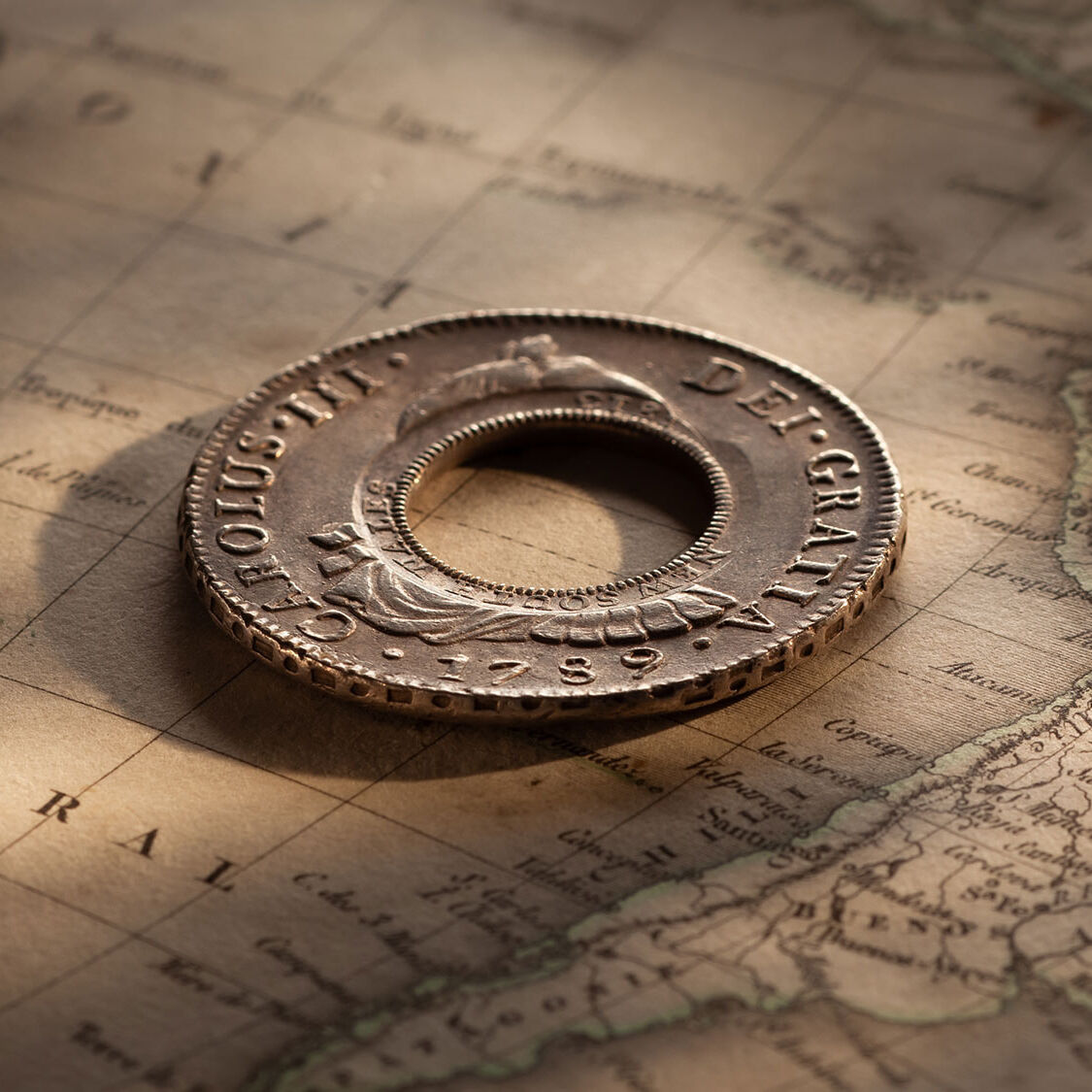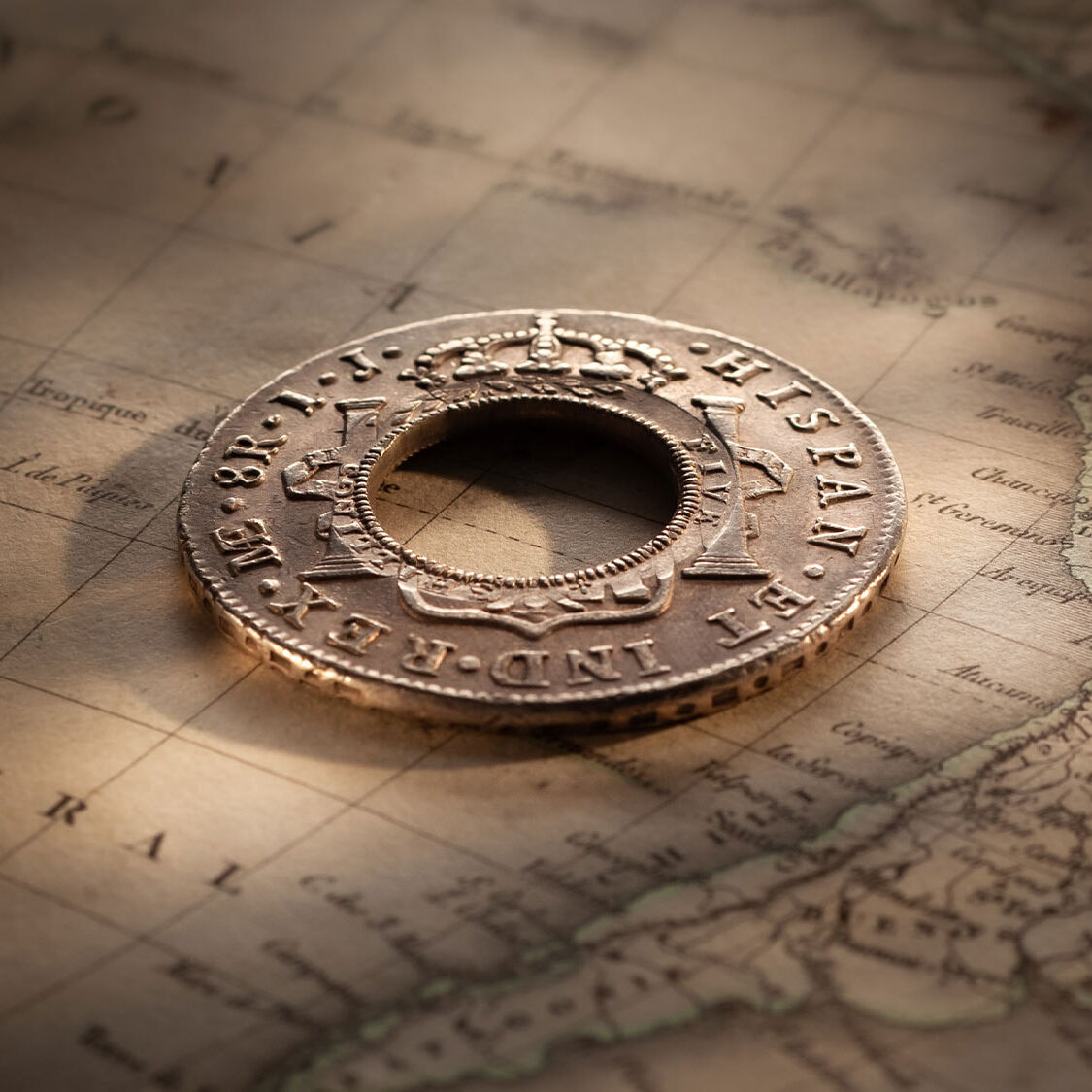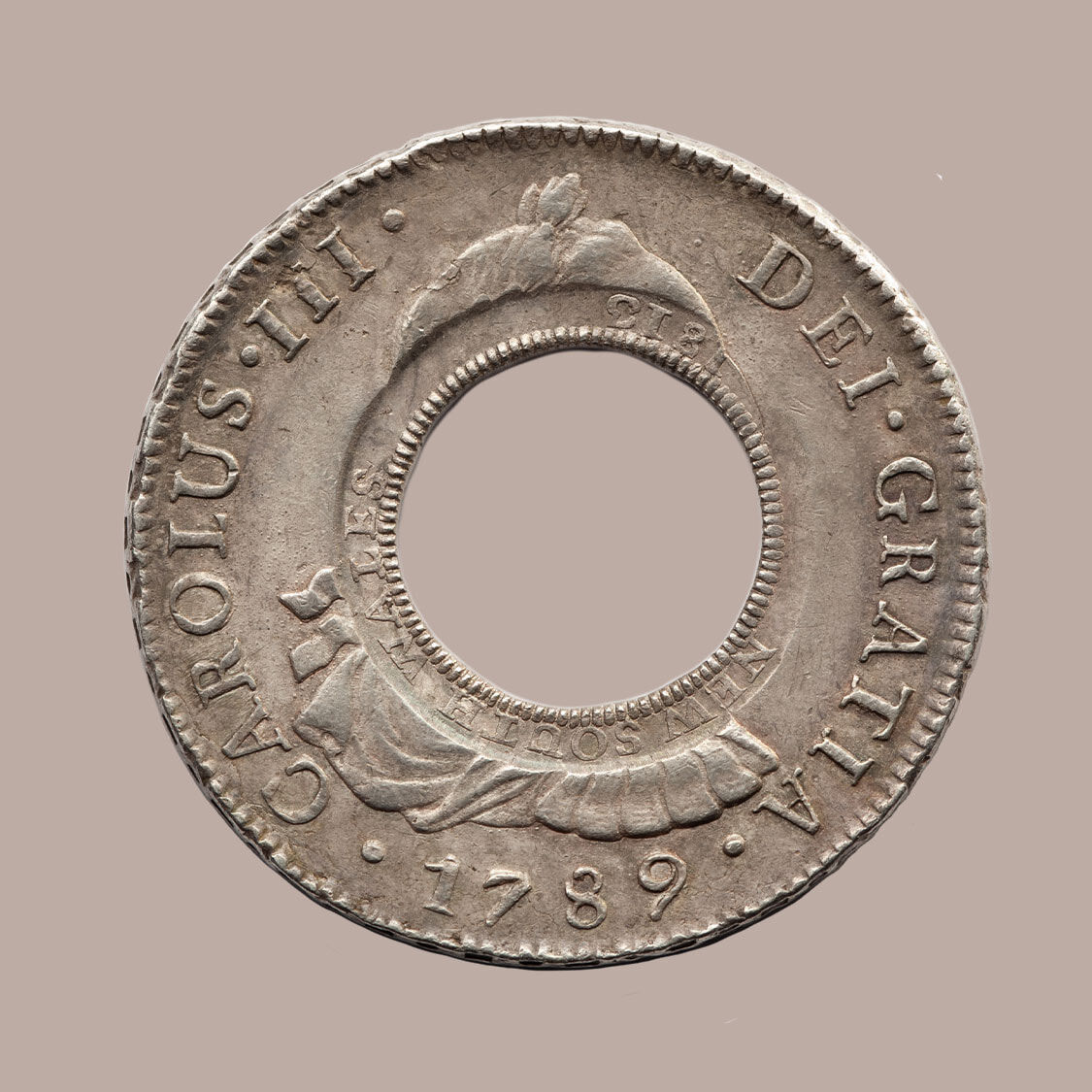Unique 1813 Holey Dollar, created from a Lima Mint Spanish Silver Dollar struck in 1789 during the reign of Charles IV and featuring the portrait and legend of the deceased monarch, Charles III


The Holey Dollar is the nation’s first coinage, introduced by Governor Lachlan Macquarie.
It is the 'coin with the hole', cut from an imported Spanish Silver Dollar into a donut form. And over stamped around the inner edge of the hole with the date 1813 to signify its year of issue.
Forty thousand Spanish Silver Dollars were imported to create forty thousand Holey Dollars, the nation's first circulating currency.
Governor Lachlan Macquarie wasn’t fussy about the dollar's quality. Nor did he care about the date, the reigning monarch or the mint at which the dollars were struck.
Some dates were more represented than others. Some mints were also more represented than others, the Mexico Mint prolific in its silver coin production by comparison to the mints at Lima or Potosi that were modest producers.
Thirty-nine thousand, nine hundred and ten Holey Dollars were delivered to Governor Macquarie. Spoilage and the despatch of samples back to Britain accounting for the missing ninety coins.
Today, approximately one hundred and ninety four Holey Dollars are held in private hands.
Those one hundred and ninety four examples are classified into types based on the reigning monarch at the time AND the legend and portrait of the monarch depicted on the Spanish Silver Dollar. The monarchs cover the spectrum from Ferdinand VI, Charles III, Charles IV, Joseph Bonaparte and Ferdinand VII.
There are seven distinct types of Holey Dollars.
• twenty-four (or twelve per cent) were created from silver dollars that were struck during the reign of Charles III and feature his legend and portrait. We refer you to the purple text in the below chart.
• two (or one per cent) were created from silver dollars that were struck during the reign of Charles IV and that feature the legend and portrait of the deceased King Charles III. (This coin one of the two.) We refer you to the green text in the below chart.
• by comparison, seventy two per cent of the privately owned Holey Dollars were created from silver dollars struck during the reign of Charles IV and that depict his legend and portrait. We refer you to the orange text in the below chart.
The chart below details the seven types of Holey Dollars, and the protocols for their classification based on the legend and portrait of the ruling Spanish monarch. The availability to collectors of each type is also shown.
This Holey Dollar is one of the rarest types, with only two examples available to private collectors.

Remarkable quality and an early date for with a quality grading of Extremely Fine, this is the finest Charles III Holey Dollar available to collectors.
If a Holey Dollar had been struck from a bright and shiny brand-new piece of silver, we would accept that some, maybe many, would survive today relatively unscathed.
The Holey Dollar, however, was struck from a Spanish Silver Dollar, a commodity that was far from shiny and brand-new. The coin was heavily traded worldwide with most well-used and worn.
And this Holey Dollar was created from a silver dollar that was issued in 1789.
The coin is in a miraculous state when you consider that the original silver dollar circulated twenty-four years before it was imported into the colony of New South Wales by Governor Lachlan Macquarie and plucked out of the barrel by his cohort William Henshall and defaced by cutting a hole in it.
More than two decades. Plenty of opportunities for wear. And plenty of opportunities for defects. None of which are evident. There is only a hint of wear to the high points.
Now, we have handled a Holey Dollar that was struck from a Potosi Mint 1807 Spanish Silver Dollar. Graded at Extremely Fine, it's an exciting coin because Holey Dollars at this quality level are extremely scarce, in the top seven per cent of known surviving examples.
But which coin is the more remarkable? An Extremely Fine Holey Dollar struck from an 1807 Spanish Silver Dollar that circulated six years before William Henshall got his hands on it. Or an Extremely Fine Holey Dollar struck from a Spanish Silver Dollar that was minted in 1789 and circulated twenty-four years before Henshall punched the hole into it. The answer is obvious.

The earlier the date of the Spanish Silver Dollar, the greater the period of circulation before it came into Henshall’s hands.
So, the earlier the date, the more remarkable the occurrence of finding a top-quality Holey Dollar.
The conundrum of this Holey Dollar is how the 1789 Spanish Silver Dollar escaped being used. How did it retain a pristine condition during the thirty-six years before it arrived in the colony and was grabbed out of a barrel by William Henshall?
In the eighteenth-century Spain ruled the world and the Spanish Silver Dollar dominated trade. It was an international currency and medium of exchange the world over. The reason why most Holey Dollars are found today well worn.

How a Spanish Silver Dollar became the 1813 Holey Dollar.
Governor Lachlan Macquarie etched his name into numismatic history forever when in 1812 he imported 40,000 Spanish Silver Dollars to alleviate a currency crisis in the infant colony of New South Wales.
Macquarie’s order for Silver Dollars did not specify dates. Any date would do. He wasn’t concerned about the various mints at which they were struck. Nor was he fussy about the quality of the coins. The extensive use of the Spanish Silver Dollar as an international trading coin meant that most were well worn.
Concluding that the shipment of 40,000 Spanish Silver Dollars would not suffice, Macquarie decided to cut a hole in the centre of each dollar, thereby creating two coins out of one, a ring dollar and a disc. It was an extension of a practice of ‘cutting’ coins into segments, widespread at the time.
Macquarie needed a man skilled in coin techniques to carry out his project. William Henshall acquired his skills as an engraver in Birmingham, where the major portion of his apprenticeship consisted of mastering the art of die sinking and die stamping for the shoe buckle and engraved button trades. He was apprehended in 1805 for forgery (forging Bank of England Dollars) and sentenced to the penal colony of New South Wales for seven years.
Enlisted by Lachlan Macquarie as the colony’s first mint master, Henshall commenced the coining process by cutting out a disc from each silver dollar using a hand-lever punch.
He then proceeded to re-stamp both sides of the holed dollar around the inner circular edge with the value of five shillings, the date 1813 and the issuing authority of New South Wales.
Other design elements in this re-stamping process included a fleur de lis, a twig of two leaves and a tiny ‘H’ for Henshall.
The holed coins were officially known as ring, pierced or colonial dollars and although ‘holey’ was undoubtedly applied to them from the outset, the actual term ‘holey’ dollar did not appear in print until the 1820s. We refer to the coins today as the 1813 New South Wales Five Shillings (or Holey Dollar).
The silver disc that fell out of the hole wasn’t wasted. Henshall restamped the disc with a crown, the issuing authority of New South Wales and the lesser value of 15 pence and it became known as the Dump. The term ‘dump’ was applied officially right from the beginning; a name that continues to this day.
In creating two coins out of one, Macquarie effectively doubled the money supply. And increased their total worth by 25 per cent.
Anyone counterfeiting ring dollars or dumps were liable to a seven-year prison term; the same penalty applied for melting down the coins. Jewellers were said to be particularly suspect. To prevent export, masters of ships were required to enter into a bond of £200 not to carry the coin away.
Of the 40,000 silver dollars imported by Macquarie, records indicate that 39,910 of each coin were delivered to the Deputy Commissary General’s Office by January 1814 with several despatched back to Britain as specimens, the balance assumed spoiled during production.
The New South Wales colonial administration began recalling Holey Dollars and Dumps and replacing them with sterling coinage from 1822.
The Holey Dollar and Dump remained as currency within the colony until 1829. The colony had by then reverted to a standard based on sterling and a general order was issued by Governor Darling to withdraw and demonetise the dollars and dumps.
The recalled specie was eventually shipped off to the Royal Mint London, melted down and sold off to the Bank of England for £5044.
It is estimated that approximately 300 Holey Dollars exist today of which a third are held in public institutions with the balance owned by private collectors.
© Copyright: Coinworks
